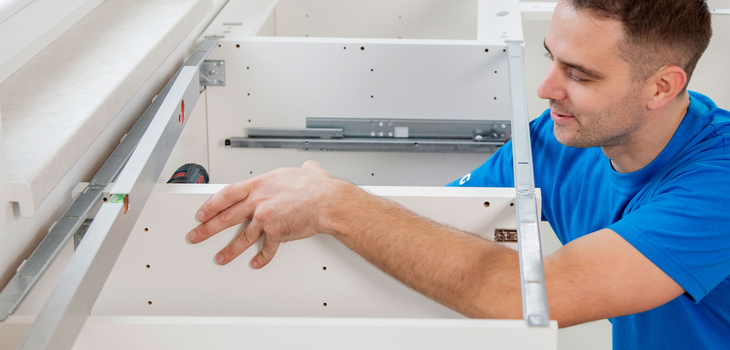Adapting to Change: Navigating Challenges in the Kitchen Assembly Industry

Increased Material Costs
Like other sectors, the economic hardship plaguing the world also affected the kitchen assembly industry. The fluctuations in raw materials prices, exchange rates, and tariffs negatively impact the production costs and markup for the sector.
Difficulty in Finding Skilled Laborers
The number of skilled labourers and technicians available is declining day by day. Hence, finding people who are kitchen assembly services experts is challenging. Skilled labourers are worse during periods of a low unemployment rate, making the industry experience a shortage of staff and a skills gap.

The kitchen assembly industry is faced with different types of challenges. Most of the time, these kitchen assembly challenges result from the trends in the industry. The world is evolving, and knowing how to navigate these challenges is paramount to succeeding in the industry.
In this blog, we will explore the challenges that the kitchen assembly industry is facing. We will see how to successfully navigate the kitchen assembly challenges and adapt to the change.
Kitchen assembly is a dynamic sector that is essential to shaping modern homes. Over the years, the need for a functional and aesthetically pleasing kitchen has increased. As the demands increase, the industry's dynamic nature challenges also increase.
These challenges must be addressed so the sector can remain relevant and experience sustainable growth. Also, it will help the industry to position themselves better while navigating the ever-changing nature of the sector.
Key Challenges Faced by Kitchen Assembly Professionals
The kitchen assembly industry faces challenges that require careful navigation and strategic positioning. Below are some of them:
Disruption of the Supply Chain System
Most of the primary materials used by the kitchen assembly industry are from the global supply chain system. Hence, they rely heavily on it for raw materials, finished products, and other components. Unfortunately, disruptions such as trade disputes, increased production costs, and natural disasters have affected the supply chain and caused delays and shortages in the industry.
Dynamic Consumer Preferences
Consumer preferences for their kitchen stuff are ever-evolving. Most people tailor their kitchen designs to trends, cultural influences, and technology. This makes it difficult for the industry to keep abreast of the changes. Also, catering to each customer's needs can take time and effort.
Regulatory Compliance and Quality Standards
Globally, it is essential to strictly comply with your sector's regulatory requirements and quality standards. Kitchen assembly is no exception; they also abide by the rules and regulations to ensure product safety and good performance. However, adapting to changes in laws and conducting regular control inspections can be difficult because of the industry's dynamic nature.
Competition from Online Retailers
Technological advancements have caused an increase in the number of e-commerce and online retailers. This has increased the competition between the traditional and online vendors since they compete for the same number of customers.
Rapid Advancement of Technology
New technological tools such as augmented reality (AR) and smart appliances are changing the narrative of the kitchen assembly industry. It is now difficult to keep up with the new changes that come out now and then.
Difficulty in Sustaining Eco-friendly Practices
Consumers have become more aware of their environment in recent years, demanding eco-friendly and suitable kitchen solutions. However, keeping up with these sustainable practices can take time, as consumers have different preferences and need different kitchen solutions.
Strategies for Successfully Adapting to Industry Changes
Adapting to changes means you should have strategies and a proactive approach. This way, you will continually adapt to the market dynamics in the kitchen assembly industry. Below are some of the strategies that will help in overcoming industry challenges:
Market Intelligence
As an industry, you must stay abreast of emerging trends and market dynamics through diligent research. You can also research competitor strategies, consumer preferences, and recent industry developments to identify and grab opportunities quickly.
Adopt a Flexible Business Model
You should adopt a flexible business model that can quickly adapt to the evolving market conditions. You can do this by splitting yourselves into teams and collaborating, innovating, and implementing new ideas to help the industry stay ahead of the curve.
Flow With the Technological Advancements
The industry should embrace new technological innovations to increase the efficiency of the kitchen assembly processes. To do this, you can invest in advanced manufacturing technologies such as computer-aided design and robotic automation.
Customisation and Personalization
To cater to the many preferences of customers, you can offer customised and personalised kitchen assembly solutions. This way, you would have tamed their appetite to only what the industry can offer. Also, you can leverage digital design tools and interactive platforms to allow customers and professionals to co-create the client's ideal cooking space and other kitchen services.

Optimise the Supply Chain System
You can optimise the supply chain system by diversifying your suppliers and reducing lead times. Also, the industry can collaborate with key stakeholders, such as suppliers, distributors, and logistics members, to reduce the incidence of late deliveries.
Embrace Eco-friendly Practices
The industry should integrate eco-friendly practices into all sectors, including product design, manufacturing, and distribution. You can use renewable materials to minimise waste and optimise energy consumption. Also, the industry must adhere to environmental standards when working.
Prioritise Customer Satisfaction
Getting customers is now competitive with the advent of social media and online vendors. Hence, prioritise customer satisfaction and engagement by offering exceptional products, services, and support to get more customers. Listen and appreciate their feedback and tailor your kitchen solutions to their needs. This way, you will cultivate long-term relationships with the customers.
Talent Recruitment, Training, and Retention
Since getting skilled labour might be a problem, the industry should invest in recruitment, training, and retaining people with expertise in kitchen assembly. Also, it fosters a culture of creativity, learning, and empowerment to attract skilled professionals to the industry.
Conclusion
There are many challenges facing the kitchen assembly industry. Hence, finding ways and strategies to adapt to them is essential. With the strategies above, we are sure that the kitchen assembly sector will be able to navigate industry changes, stay ahead of the competition, and thrive in the marketplace.
At Moovick, we connect you with kitchen assembly services you are compelled to reckon with in the marketplace.
Popular Articles

Easy Tasks to Fill Your Wallet in Germany

How to Use AI for Precise Moving Cost Calculations

Buying a Used Car in Germany for Expats: Ultimate Guide

How can I become a German citizen?

Choosing Packers and Movers in Germany- A Guide for Individuals

Commercial Electrical Maintenance: Ensuring Safety and Efficiency

